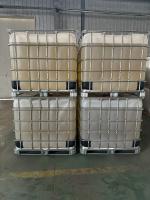Polyamine of magnafloc 1597 can be replaced by Chinafloc EM2050
Polyamine of magnafloc 1597 is a kind of polyamine with 50% solid content and medium viscosity ,can be used in water treatment ,can be replaced by Chinafloc EM2050 .food industrial ,agricult and other applications.ChinaFLOC em2050 can replace of them.
Polyamines, a group of organic compounds that include putrescine, spermidine, and spermine, are integral to a wide array of biological processes due to their interactions with DNA, RNA, and proteins. These interactions make polyamines essential in cell growth, proliferation, and differentiation. Their applications span several fields, from medicine and agriculture to material science and environmental management.
1. Biomedical and Healthcare Applications
In the realm of healthcare and medicine, polyamines have gained significant attention due to their involvement in cell life and death, which has implications for various diseases, including cancer, aging-related diseases, and cardiovascular conditions.
-
Cancer Research and Treatment: Cancer cells exhibit a marked increase in polyamine levels, which are believed to contribute to tumor growth and progression. This has led to the exploration of polyamine metabolism as a target for cancer therapy. Drugs that inhibit polyamine synthesis or function are being developed to combat cancer. Moreover, the polyamine pathway is a focus in cancer diagnostics, with elevated polyamine levels serving as potential biomarkers for certain types of cancer.
-
Aging and Longevity: Studies have indicated a link between polyamines, particularly spermidine, and aging. Polyamines are thought to promote cellular autophagy, a process that clears damaged cells and helps maintain cellular health. There is growing interest in polyamines as potential anti-aging compounds, with research exploring their role in extending lifespan and reducing age-related cellular damage.
-
Neurodegenerative Diseases: Polyamines may play a protective role in the nervous system. Their involvement in modulating ion channels and receptors in the brain indicates potential therapeutic applications in neurodegenerative diseases like Alzheimer's and Parkinson's. By protecting neurons and promoting neural growth, polyamines could help mitigate the effects of these conditions.
-
Cardiovascular Health: There is evidence suggesting that polyamines have cardioprotective properties. They may help reduce the risk of heart disease by affecting cellular processes in heart muscle and blood vessels.
2. Agricultural Applications
In agriculture, polyamines are recognized for their role in plant growth and development. They are involved in key processes such as:
-
Seed Germination and Root Growth: Polyamines are known to enhance seed germination rates and promote root growth, essential for healthy plant development.
-
Stress Response: Plants under environmental stress (drought, salinity, extreme temperatures) often show increased levels of polyamines. These compounds help in stress tolerance, possibly by stabilizing cellular structures and scavenging free radicals.
-
Fruit Ripening and Quality: Polyamines influence fruit development and ripening, impacting agricultural yield and quality. Their regulation can be used to improve shelf-life and reduce post-harvest losses.
3. Food Industry Applications
In the food industry, polyamines have a dual role. On one hand, they are natural components of many foods and are necessary for growth and health. On the other hand, their levels need to be monitored:
-
Nutritional Benefits: Polyamines in food contribute to cell growth and gut health. They are found in a variety of foods, including fruits, vegetables, meats, and cheeses.
-
Food Safety and Preservation: High levels of polyamines can be indicative of spoilage or bacterial contamination. Monitoring and controlling their levels is essential for ensuring food safety.
4. Material Science and Industrial Applications
Polyamines are also valuable in material science and industry:

